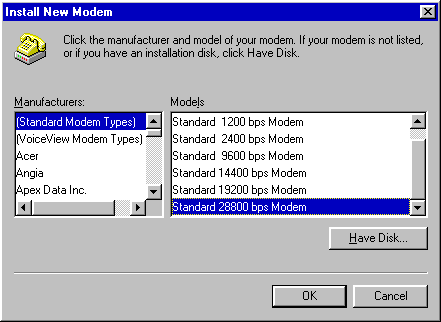
Windows 3.1x installation
Windows
3.1x has no specific setup routine for modems. Instead, it relies on each of the
communications programs you use to correctly handle the modem. As you might guess, this is
not an entirely satisfactory situation, although it's not as bad as it sounds. Here are
some hints:
- Modems come factory configured to work out of the box and,
most of the time, that's just what they do.
- If you have an internal modem, you may need to set some DIP
switches to ensure the modem doesn't have conflicts with other devices in your system. The
switch settings should be detailed in your modem manual.
- Many modems come with their own communications program, tested
or customised to ensure that it works properly with the modem. If you're using Windows
3.1x, you'll find it's best to stick to the communications package supplied with your
modem, or to communications packages which specifically recognise your modem.
- If the communications program you want to use doesn't 'know'
your modem, you can usually get by with selecting 'Hayes compatible' from the list of
options. The US company, Hayes, used to dominate the modem world, and developed a set of
commands (called AT commands) that still form the basic language of modems. Chances are
your modem will function adequately if you identify it as Hayes compatible. You may even
be able to choose a similar speed -- for example, if you have a 14.4Kbps modem, you may be
able to select 14.4 Hayes compatible.
- One word of warning: if you want to use an external high-speed
modem (anything over 19,600bps) then you need to ensure the serial card in your computer
has a 16550A UART chip. Specifically, an NS16550A chip from National Semiconductor. The
acronym stands for universal asynchronous receiver transmitter (I'm sure knowing this will
enrich your life) and this little chip controls the speed your computer can pass
information to and from the modem. You can get non-NS16550A chips, but they're not always
compatible with all serial devices.
- Windows 3.1 and Windows 3.11 both have some troubles handling
communications at these higher speeds. You'll need a piece of software called a
communications driver to update your system and gain the benefit of the high speeds. For
Windows 3.1, you'll need a program such as cybercom.drv (available to download from ftp://ftp.tiac.net/windows -- look for
cybercom.zip). For Windows 3.11, you may find you need an updated version of the
serial.386 file (from ftp://ftp.microsoft.com/Softlib/MSLFILES/wg1001.exe).
- Frankly, Windows 95 runs rings around Windows 3.1x when it
comes to communications and the best advice I can give to anyone serious about spending
time online is to take the plunge and upgrade. It'll make installation and connections
easier, provide full in-built support for high-speed modems, and allow you to perform
other tasks while waiting on those eternal downloads from the Web.
|

![]()


